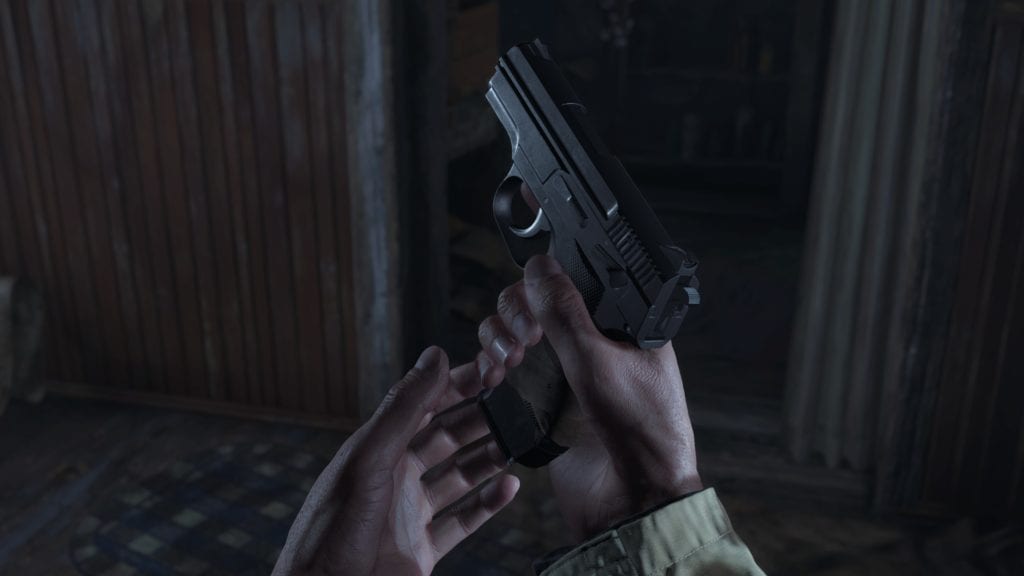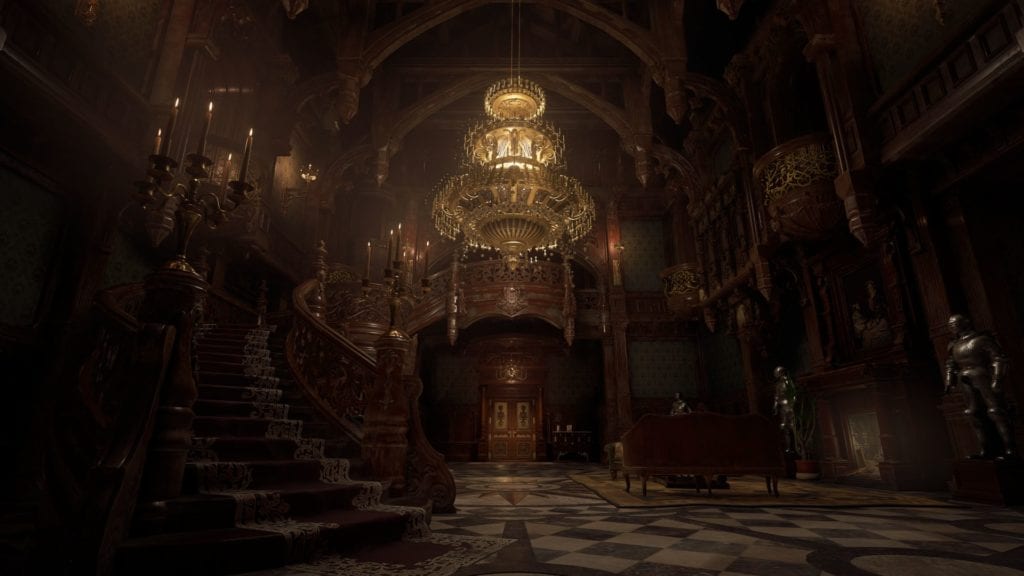Title – Resident Evil Village
Platforms – PS5, PS4, Xbox Series X/S, Xbox One and PC
Release Date – May 7th, 2021
Developer – Capcom
Publisher – Capcom
MSRP – $59.99
ESRB – M for Mature
Disclaimer – This product is being reviewed on the PlayStation 5. A review copy was provided by the Gaming Instincts staff for the purpose of this review. This review may also contain spoilers for certain gameplay and story elements. Watch at your own risk, you have been warned. Gaming Instincts is an Amazon Affiliate and does gain financial benefits if you choose to purchase this product on this page.
Resident Evil has always struggled to find a stable middle ground between ludicrous action and terrifying horror, with some entries leaning too heavily on one side or the other. Gamers could be punching boulders in one of the games, only to pivot to being paralyzed by fear in another installment. This strenuous balancing act endures to this day, a conflict of tones and ideas that the latest mainline entry tries to resolve.
Though it falls short in its attempt to unify the broader franchise’s contrasting elements, Resident Evil Village still manages to be a fun experience. The game leaning heavily on Resident Evil’s more ridiculous aspects and history does cause problems, but that’s countered by the overall experience being entertaining and diverse in atmosphere. Imperfect though the end result may be, it’s hard to argue that Village isn’t also a good time.
The Village: A Mysterious, Blood Curdling Character – (Setting)
Village acts as a direct sequel to Resident Evil 7: Biohazard, focusing on the continuing trials and tribulations of Ethan Winters. After an unwelcome appearance by series regular Chris Redfield results in the kidnapping of Ethan’s infant daughter Rose, Ethan is once again pulled into the dire realm of bio mutants and grim conspiracies. However, this adventure sees the hapless man pitted against Lycan, witches, and a dysfunctional village – all of which need to be overcome to rescue Rose.
The narrative might not win any awards but it succeeds in its goal of delivering an entertaining storyline with interesting revelations and solid emotional stakes. Village establishes a campy feel to its events that endures over its 8-to-12 hour runtime, with decent twists woven into the plot. More surprising than that, though, is Ethan’s increased likability as a protagonist, owing to the game calling attention to his unceasing love for Rose. That having been said, for all that Village’s storytelling manages to accomplish, it’s hard not to feel as though the game’s titular setting is the more substantive draw.
Much of the village’s appeal is tied to Capcom’s perfect blend of exquisite detail, unsettling touches, and semi-realistic design choices. The game’s use of the RE Engine allows for impressive environmental details like the glimmering of shined wood, floating dust particles, and bloodstains across large wooden surfaces. By fleshing out the game’s central locale to such a thorough extent, Capcom ensures that the village feels like a character in itself, complete with personalities and secrets to uncover.
This is all the more apparent given that the village serves as a home base of sorts, wherein interesting activities can be undertaken and useful tools can be found. In the village, Ethan can hunt animals that can be traded for upgrades, find optional yet helpful loot, and fight a variety of creatures. There are times when important equipment, such as a grenade launcher and an automatic shotgun, can only be found through optional exploration. This free-flowing extension of plot-related exploration proves vital to the enjoyment of Village as a whole, never mind how it relates to the game’s appreciation for Resident Evil’s legacy.
Speaking of which, this home base functionality might be a new system, but it aligns neatly with the series’ established gameplay conventions. As per tradition, Ethan must find tools to open certain paths within the village. For instance, a crank can be discovered and used to obtain loot hidden inside of various wells. Suffice to say, the village offers a rewarding sense of progression and satisfying shortcut possibilities, though it is far from the only place in the game to manage this feat.
In addition to the village, Ethan will navigate a large range of other compelling environments. The heavily advertised castle, for example, is an illustrious setting that practically screams of opulent excess. It’s a far cry from the decrepit village and all the other environments scattered around its outskirts. The sheer amount of variation between settings is astonishing, proving that one of Village’s greatest assets is the unique personality of each new locale.
Weighing Horror with Action – (Gameplay)
Where Resident Evil 7 honed in on the horror aspects of the franchise, Village scales back on fear in favor of first-person action. The player is faced with almost nonstop setpieces instead of the slower, stalking-focused gameplay of Biohazard. Here, Ethan can find himself escaping a crumbling building, before immediately having to run away from a ceiling of spikes. This shift towards an action-first design model is further emphasized by the game’s take on ammo conservation and inventory management.
Village’s distribution of items, in particular ammunition for weapons, feels deprioritized and arguably undercut in a way that leaves little doubt Capcom was aiming to make a high-intensity first-person shooter above all. In Village, Ethan always has enough bullets for every encounter, meaning it is within the realm of possibility that the player can kill every menacing monstrosity in their path. Even in instances where ammo isn’t strewn throughout a given location, Ethan can buy or craft supplies with ease. Though Capcom’s decision to shape the game’s equipment around its combat encounters and action makes sense given the intended experience, it brushes up against the reality of Village’s more dated design elements.
Put another way, Village can’t reconcile its gameplay ambitions with the awkward nature of its shooter mechanics, which becomes a severe problem as the game’s stakes escalate. There are instances where the game will bombard Ethan with enemies and expect him to shoot all of them down. Whereas the tight controls of a Call of Duty game might be suited to meet such a demand, Village’s clunkiness and enforcement of player vulnerability in the name of survival horror is a poor fit. At its core, Resident Evil’s design is antithetical to the very encounters into which Village tries to place before its audience.
It’s fortunate, then, that Capcom made the wise decision to have Village run the player through a range of unpredictable and increasingly ludicrous situations. The game’s objectives range from navigating an unpleasant slime maze to dodging the flippant attack of a giant fish, ensuring that the audience never knows what to expect. If nothing else, this bombardment of random events ensures Village never feels repetitive.
Amid its action-heavy scenes, Capcom tries to throw in some terrifying moments that do manage to impress, even while feeling somewhat out of place. There’s one scene involving twitching dolls and an elaborate mannequin puzzle that, without going further into spoilers, does prove to be both the game’s high point and one of the scariest moments in franchise history. However, many of the nods to horror have the side effect of suggesting the game as a whole is torn between what genre it actually wants to represent. That internal conflict threatens to overshadow sequences that might otherwise stand among the best that Resident Evil has to offer.
In much the same way that the game’s attempts at embracing horror leave much to be desired, Lady Dimitrescu is a huge disappointment compared to how she was depicted in the marketing leading up to Village’s release. The large villainess, striking though her all-white attire may be, receives little screen time and fails to pose much of a threat. Furthermore, Dimitrescu’s highly promoted stature proves to be something of an unfortunate disadvantage; she struggles with doorways, making it easy to escape her grasp. One has to wonder how much more satisfying Dimitrescu might have been as an adversary if not for the expectations set by the promotional material.
A Strange Dissonance – (Final Verdict)
In many ways, Resident Evil Village is a purposefully simplistic game that knows its audience and delivers on its promises. It respects the player’s time by giving them a dense central location to explore and provides a generous supply of resources with which to keep its plot momentum strong. It goes to these lengths so as to ensure players can bask in the set pieces and the absurd heights of its storytelling. The game understands what it wants to do and manages to accomplish it in style.
Of course, the game’s dedication to action can drive Village into a strange dissonance of tone and genre. Village’s struggle to stage compelling and polished combat encounters are not improved by the pairing of such scenes with obligatory horror sequences. Still, for all the game’s missteps in the realm of genre-blending and coherent game feel, it does manage to be an admirable distillation of Resident Evil’s base appeal: the feeling of joy that comes from shooting large beasts in an enriching, lore-heavy setting.






